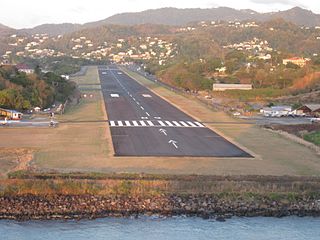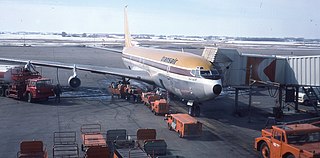
Hewanorra International Airport, located near Vieux Fort Quarter, Saint Lucia, in the Caribbean, is the larger of Saint Lucia's two airports and is managed by the Saint Lucia Air and Seaports Authority (SLASPA). It is on the southern cape of the island, about 53.4 km (33.2 mi) from the capital city, Castries.
Air Jamaica was the national airline of Jamaica. It was owned and operated by Caribbean Airlines from May 2011 until the cessation of operations in 2015. Caribbean Airlines Limited, headquartered in Piarco, Trinidad and Tobago, had administrative offices for Air Jamaica located at Norman Manley International Airport in Kingston, Jamaica.

Owen Roberts International Airport is an airport serving Grand Cayman, Cayman Islands. It is the main international airport for the Cayman Islands as well as the main base for Cayman Airways. The airport is named after British Royal Air Force (RAF) Wing Commander Owen Roberts, a pioneer of commercial aviation in the country, and is one of the two entrance ports to the Cayman Islands.
Cayman Airways is the flag carrier airline of the British Overseas Territory of the Cayman Islands. With its head office in Grand Cayman, it operates mainly as an international and domestic scheduled passenger carrier, with cargo services available on most routes. Its operations are based at Owen Roberts International Airport in George Town, Grand Cayman. The company slogan is Those who fly us love us.

George F. L. Charles Airport is the smaller of the two airports in Saint Lucia, the other being Hewanorra International Airport. It is located 2 km (1.2 mi) north of Castries, the capital city. George F. L. Charles Airport is managed by the Saint Lucia Air and Seaports Authority (SLASPA). Its runway runs parallel to a pristine beach, Vigie Beach, which is a popular tourist attraction.

Philip S. W. Goldson International Airport is an airport that serves the nation of Belize's largest city, Belize City along the eastern coast of Central America. It was named after politician Philip S. W. Goldson, who died in 2001. The airport is at an elevation of 5 m (16 ft), which means both the airport and the entirety of Belize City are at risk of serious flooding due to its low elevation and coastal location. For this reason, Belize's capital has been moved to Belmopan, but the airport remains the largest and busiest in the country. With stable passenger growth, Philip S. W. Goldson International Airport is currently the fifth busiest airport in Central America. Belize Airport covers 457 acres of land and has one runway.

Combi aircraft in commercial aviation are aircraft that can be used to carry either passengers as an airliner, or cargo as a freighter, and may have a partition in the aircraft cabin to allow both uses at the same time in a mixed passenger/freight combination. The name combi comes from the word combination. The concept originated in railroading with the combine car, a passenger car that contains a separate compartment for mail or baggage.

Fort Smith Regional Airport is a public use airport located near the Interstate 540 freeway three nautical miles (6 km) southeast of the central business district of Fort Smith, in Sebastian County, Arkansas, United States. FSM is governed by the Fort Smith Airport Commission as established by the City of Fort Smith, Arkansas. It serves the transportation needs of residents and businesses of western Arkansas and eastern Oklahoma. FSM is currently served by American Eagle, the regional airline affiliate of American Airlines. It has a large population of corporate and general aviation aircraft. A full-service fixed-base operator (FBO), Signature Flight Support, provides service to general aviation, airline, and military operators.

Juneau International Airport is a city-owned, public-use airport and seaplane base located seven nautical miles northwest of the central business district of Juneau, a city and borough in the U.S. state of Alaska that has no direct road access to the outside world. The airport serves as a regional hub for all air travel, from bush carriers to major U.S. air carriers such as Alaska Airlines.

Piarco International Airport is an international airport serving the island of Trinidad and is one of two international airports in Trinidad and Tobago. The airport is located 30 km (19 mi) east of Downtown Port of Spain, located in the suburban town of Piarco. The airport is the primary hub and operating base for the country's national airline, as well as the Caribbean's largest airline, Caribbean Airlines.

Providenciales International Airport, on the island of Providenciales in the Caicos Islands, is the main international airport serving the Turks and Caicos Islands, a British Overseas Territory of the United Kingdom. It is operated by Turks and Caicos Islands Airports Authority (TCIAA). The territory's other international airport is JAGS McCartney International Airport on Grand Turk Island. Currently, there are more than 12,000 commercial aircraft operations per year.

Sir Captain Charles Kirkconnell International Airport is an airport serving Cayman Brac, Cayman Islands. It is one of the hubs for Cayman Airways with flights to Owen Roberts International Airport on Grand Cayman, and Edward Bodden Airfield on Little Cayman. It is the only airport on Cayman Brac.

Cheddi Jagan International Airport, formerly Timehri International Airport, is the primary international airport of Guyana. The airport is located on the right bank of the Demerara River in the city of Timehri, 41 kilometres (25 mi) south of Guyana's capital, Georgetown. It is the larger of the two international airports serving Georgetown with the other airport being the Eugene F. Correia International Airport.

Douglas–Charles Airport, formerly known as Melville Hall Airport, is an airport located on the northeast coast of Dominica, 2 mi (3.2 km) northwest of Marigot. It is about one hour away from the second largest city Portsmouth. It is one of only two airports in the island nation of Dominica, the other being Canefield Airport located three miles (5 km) northeast of Roseau.

Transair was an airline based in Canada. It was purchased by Pacific Western Airlines in 1979. Transair's operational headquarters was located at the Winnipeg International Airport in Manitoba.

JAGS McCartney International Airport, also known as Grand Turk International Airport, is an airport located 1 mile (1.6 km) south of Cockburn Town on Grand Turk Island in the Turks and Caicos Islands, an overseas territory of the United Kingdom. It is the second largest airport in the territory, after Providenciales International Airport.
Guyana Airways was the flag carrier of Guyana. During its operations, Guyana Airways operated services to destinations in the Caribbean, the United States and Canada. The airline was headquartered in Georgetown, Guyana. It was declared insolvent in 2001.

Caribair was a Puerto Rican airline based in San Juan, Puerto Rico, that served over a dozen destinations in the Caribbean as well as Miami. In 1970, the air carrier was serving 16 destinations on 14 Caribbean islands, plus Miami. The airline offered McDonnell Douglas DC-9-30 jet service via a number of intermediate stops including San Juan (SJU) for its direct flight services between Miami (MIA) and Port of Spain, Trinidad. Caribair was the first Puerto Rico-based airline to operate jet aircraft on scheduled passenger services. The air carrier was acquired by Eastern Air Lines in 1973.

Caribbean Airlines Limited is the state-owned airline and flag carrier of Trinidad and Tobago. It is also the flag carrier of Jamaica, with the Government of Jamaica having approximately 11.9% ownership. Headquartered in Iere House in Piarco, the airline operates flights to the Caribbean, North America and South America from its base at Piarco International Airport, Trinidad. Presently Caribbean Airlines employs more than 1,700 people and is the largest airline in the Caribbean. The company slogan is The Warmth of the Islands.
Trinidad and Tobago Air Services also known as the TTAS, was an Air Bridge service for Trinidad and Tobago. It was based at Piarco International Airport, Trinidad and Tobago.























